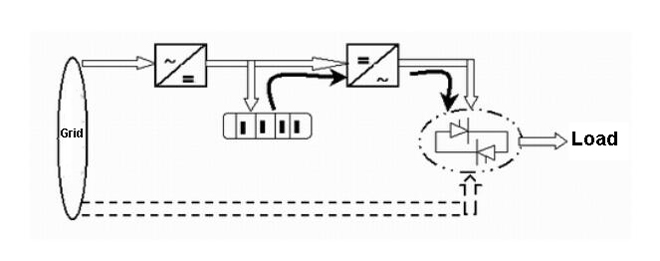Uninterruptible power supply (UPS), how it works?
How does an uninterruptible power supply (UPS) work? Let's first start with the structure and function of an uninterruptible power supply, and then move to the details of the UPS working principle.
UPS power system consists of 4 parts: rectification, energy storage, transformation and on-off control. UPS realizes the function of voltage stabilization with rectifier, which is generally a silicon-controlled rectifier (SCR) or high-frequency switching rectifier. The rectifier controls the output amplitude according to the change of external power supply; when the power supply changes (the change should meet the system requirements), it outputs a rectified voltage whose amplitude keeps unchanged.
Purification function of UPS is completed by the energy storage battery. As the rectifier cannot eliminate instantaneous pulse interference, the rectified voltage still has interference pulse. Energy storage battery can not only store DC power, but also plays a role of large-capacity capacitor for the rectifier, its equivalent capacitance is proportional to the capacity of energy storage battery. As the voltage at both ends of the capacitor can’t change suddenly, the pulse interference is eliminated due to the smoothness property of capacitor for pulses, thus realizing the purification, as well as the shielding against interference. Converter guarantees a stable frequency of uninterruptible power supply. Frequency stability is determined by the stability of the converter's oscillation frequency. To facilitate daily operation and maintenance of UPS power system, an operating switch, automatic bypass switch after fault self-checking, overhaul bypass switch are designed in this system.
When the power at the grid works normally, the load is energized as the figure shows below and the energy storage battery of UPS is charged synchronously. When the power failure occurs suddenly, the uninterruptible power supply (UPS) starts to work and the energy storage battery provides power to the load to maintain normal production (as shown in the black →). If the load is seriously overloaded due to production needs, the grid power is directly supplied to the load after rectification (as shown by the dotted line).
UPS power system is mainly divided into two parts, the host and energy storage battery. Rated output power depends on the host, but it’s also related with the load property, because UPS power supply has different driving capability for different loads. Generally, the load power should be 70% of the rated power of UPS power supply. Energy storage battery capacity mainly depends on its reserve time after the load power is determined, and this reserve time differs from different conditions in different enterprises. The reserve time is mainly determined by the turn-on time of the spare battery, it’s generally between several minutes and several hours.
- AC-DC transformation
AC power from power grid is transformed into DC power after autotransformer voltage stepdown, full-wave rectification and wave filtering, then it’s provided to the inverter circuit. AC-DC input has a soft start circuit to avoid the impact on power grid when starting. - DC-AC inverter circuit
Full bridge inverter circuit with high-power IGBT module has great power surplus. Its output impedance is quite small in the output dynamic range, so it has the characteristic of fast response. Due to the high-frequency modulation current limiting technology and fast short-circuit protection technology, the inverter can work safely and reliably whether voltage transients, load shocks or short circuits. - Control driving
Control driving is the key to complete functional control of the whole machine. In addition to providing detection, protection, synchronization and various switches, display drive signal, it also controls the SPWM sinusoidal pulse width modulation. Due to the dual voltage feedback, the dynamic characteristics and stability of the inverter are greatly improved.

